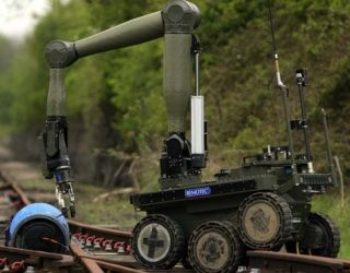Apr 23 2013
US aerospace and defence firm Northrop Grumman has unveiled brand new unmanned IED-handling and disposal technology, designed to allow roadside bombs to be safely dealt with from a remote position.
 CUTLASS unmanned ground vehicle. Image copyright: Northrop Grumman
CUTLASS unmanned ground vehicle. Image copyright: Northrop Grumman
The CUTLASS unmanned ground vehicle (UGV) was conceived, developed and built by Northrop Grumman UK, embodying what the company terms 'significant advances in technology and performance', with a variety of features intended to facilitate safe hazardous threat detection and elimination.
These features include a gripper arm able to move adeptly within confined spaces and a sensing system able to retrieve forensic data and work to limit damage caused to nearby objects.
CUTLASS UGV
The CUTLASS UGV can reportedly operate much more rapidly than all other current, in-service UGVs, since it boasts all the tools needed to deal with a threat in one 'hit', rather than have to return to the scene later on with additional IED countermeasures.
The Northrop Grumman Cutlass has a 12 kilometres-per-hour top speed but can also creep along stealthily, while its six-wheeled layout lets it cope with all terrain types.
To date, Northrop Grumman has manufactured and delivered in excess of 2,000 unmanned ground vehicles to customers the world-over. The international launch of the CUTLASS therefore only further expands the company's commitment to advancing the state of the UGV art.
Northrop Grumman CUTLASS
The CUTLASS UGV design will now be exhibited at the upcoming Counter Terror Expo event, which takes place in London Olympia between 24-25 April 2013.
"Our CUTLASS vehicle is setting new standards in the UGV market and significantly enhancing the ability of users to handle hazardous threats safely", explained Northrop Grumman Information Systems' Defence and Security managing director, Greg Roberts.
He continued: "It is more dexterous, cost effective and, as a package, four times faster than any other UGV. "The vehicle is already in service across the UK and has proven itself to be robust and capable in the most demanding environments. We look forward to exploiting the potential opportunities for exporting this capability into international markets.".
Improvised Explosive Devices have proved hugely troublesome for NATO personnel deployed in Afghanistan for the past ten years. Data recently published by Homeland Security Market Research claims that, since 2007, there has been a 400 per cent increase in IEDs laid down by insurgent forces. As a result, IED death rates have also increased by a similar percentage, while injury rates have soared 700 per cent.